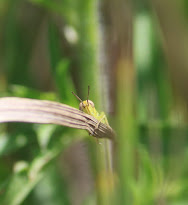I’ve had the pleasure of visiting two beautiful sand prairies in Iowa over the past year: Corriell Nature Preserve, a Bur Oak Land Trust property near Atalissa, and Big Sand Mound Nature Preserve, near Muscatine. Both preserves have restricted access to the public; the visit to Corriell was part of an Iowa Master Naturalists outing, and Big Sand Mound has a field day every few years where the public is welcomed to visit and learn about the unique ecosystem and its inhabitants (IMN was also treated to a “herp field trip” at Big Sand Mound this summer).
Sand prairies can be formed when sand is carried out of
nearby river valleys by winds and deposited, often forming hills (known as
aeolian sand hills, “aeolian” pertaining to the actions of winds), the sand
having been initially left in the wake of melting glaciers. The dry substrate
can allow unique plants to flourish, and both Corriell and Big Sand Mound had
an abundance of attractive and charismatic flowering plants including Whorled
Milkweed, Spotted Bee Balm, and Opuntia Cactus. They can also serve as a safe
haven for threatened animals; Big Sand Mound monitors populations of mud
turtles and wildlife
surveys at Corriell have revealed it is inhabited by endangered bats.
Having learned about these uncommon types of prairie, I was
intrigued to learn more about Iowa City’s own Sand Prairie, less than a mile
away from the Sycamore Greenway.
Iowa’s City’s Sand Prairie, acquired by the city in 2005, is
a 38-acre remnant that was protected from development by local activists
(development of a nearby subdivision proceeded, displacing a population of
around 50 Ornate Box Turtles, which were moved by the Iowa DNR to make way for
the houses). It is believed to be a prairie remnant, one of those rare scraps
of land in our state that managed to escape the plow (though it likely was
grazed and mined for sand).
 |
| "Not your neighborhood Honey Locust" |
Tall spikes of yellow-flowered Common Mullein abound; this velvet-leaved non-native has made itself at home here. There is also copious poison ivy blanketing the grass in many areas, with no mowed paths or trails; not a place for a casual jaunt but suitably pantsed and bootsed one can wander to the heart’s content.
 |
| Tall spikes of Common Mullein abound |
Despite these challenges, Sand Prairie is enchanting. Once
you venture over the hill and out of sight of Gilbert St., it feels secluded
and quiet. Although overcome by invading grasses and scrub, there are pockets
of small flowers that have maintained a foothold. Humongous bumble bees make
the rounds of the Bee Balm, and to my delight grasshoppers and katydids abound.
During my visit a pair of American Kestrels passed overhead and a tiny
Ruby-throated Hummingbird perched on a tree branch as an unseen Field Sparrow
sang in the distance.
Tune in to the Sycamore Greenway Friends Facebook or Instagram pages this week to see some of the floral and faunal neighbors making their
home in this Iowa City gem.
Sources/Additional Reading:
- Iowa City South District Plan (2015)
- Iowa City Natural Areas Inventory and Management Plan (2018)
- Iowa City Natural Areas: Inventory, Management Needs and Assessment (February, 2016)








